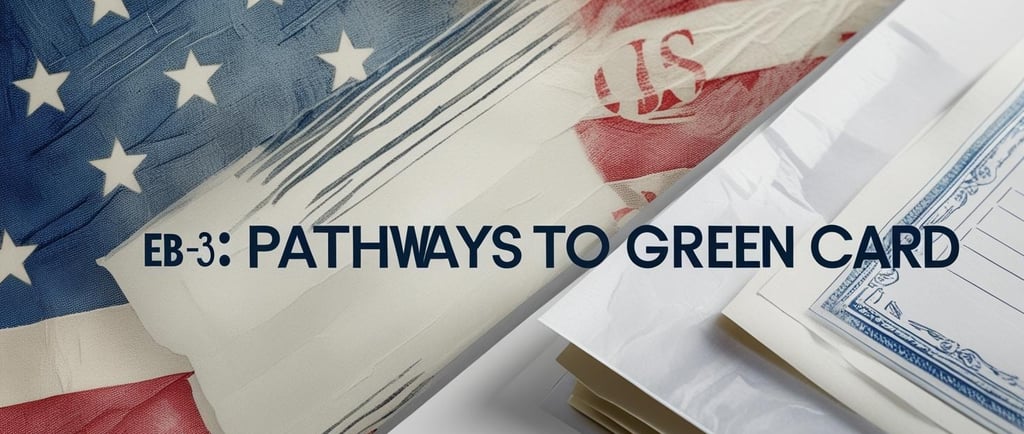EB‑3 Green Card: Your Step-by-Step Guide from Job Offer to Permanent Residency
Learn how the EB‑3 employment-based visa can help you transition from a U.S. job offer to permanent residency. This guide breaks down the process—PWD, labor certification, I‑140 petition, priority date, and green card approval—in a clear, step-by-step format for international applicants.
ASLAT Guidance
7/29/20255 min read


EB‑3: Pathways to Green Card for International Students in the U.S.
For an international students—whether you're from Nepal, India, or Bangladesh—studying in the United States is more than just earning a degree; it's a launchpad for global career growth. But for many, the dream doesn't end at graduation—it continues through the goal of securing permanent residency through a right information and guidance.
One of the most accessible immigration routes is the EB‑3 Green Card: a U.S. employment-based visa category that offers long-term stay options for students in realistic, in-demand fields like Computer Science and Nursing.
In this blog, brought to you by ASLAT Guidance, we’ll break down the EB‑3 process in simple terms, explain how you can transition from OPT or H‑1B to EB‑3, and highlight majors that align well with employer sponsorship opportunities. Whether you're a +2 graduate in Nepal aiming for B.Sc. Nursing, preparing for a Computer Science (CS) degree, or a exploring U.S. options, this guide is tailored to help you understand how the EB‑3 can be your path to a U.S. Green Card.
Understanding the EB‑3 Visa: A Gateway for Skilled Workers and Professionals
The EB‑3 visa is part of the U.S. employment-based immigration system, designed for skilled workers, professionals, and other (unskilled) workers. It's particularly accessible for international students because it doesn't require extraordinary achievements like EB-1 or advanced degrees like some EB-2 paths. Instead, it focuses on job offers from U.S. employers who can't find qualified American workers.
For an international graduates, EB‑3 is appealing despite potential backlogs in priority dates (due to high demand from countries like India). As of 2025, processing times average around 19–24 months for the full process, though waits for visa availability can extend longer for certain nationalities (India and China). The category caps at about 30,000 visas annually, with up to 10,000 for unskilled workers.
EB-3 has three subcategories:
Skilled Workers: Jobs needing at least two years of training or experience (e.g., certain tech roles)
Professionals: Positions requiring a U.S. bachelor’s degree or equivalent (e.g., Computer Science graduates)
Other Workers: Unskilled roles with less than two years of training (less common for an international students)
Key advantage: Unlike student (F-1) visas, OPT/CPT, and H-1B, EB‑3 leads directly to a Green Card, allowing you to live and work permanently in the U.S.
Step-by-Step: How the EB‑3 Visa Process Works
After understanding what EB‑3 is and whether your major aligns with it, let’s walk through the actual steps involved in securing an EB‑3 green card. It’s a structured—but detailed—process involving your employer, the Department of Labor (DOL), and U.S. Citizenship and Immigration Services (USCIS).
Here’s how it works:
1. Prevailing Wage Determination (PWD)
The process begins when your U.S. employer requests a wage determination through the Foreign Labor Application Gateway (FLAG) system.
Confirms your salary meets the minimum required (prevailing) wage for your occupation and location
Overseen by the Department of Labor (DOL)
Timeline: 6–8 months
2. Labor Certification (PERM)
If the job is not on Schedule A, your employer must prove they tried to recruit U.S. workers first:
Advertisements in newspapers and online
Minimum 30-day posting with the State Workforce Agency
30-day quiet period after recruitment
File Form ETA-9089 if no qualified U.S. workers apply
Timeline: 6–12 months (if applicable)
Note: Registered Nurses (RNs) qualify as Schedule A occupations — so this step is skipped, reducing total processing time.
3. I‑140 Petition
After PERM approval, your employer files Form I‑140 with USCIS to confirm the job offer and your qualifications.
This also establishes your priority date, which determines your place in line for a visa
Premium processing may be available for faster decisions
4. Visa Bulletin & Priority Date Wait
Each month, the U.S. Department of State publishes a Visa Bulletin. You'll monitor this to see when your priority date becomes current.
Backlogs vary: India and China often has longer waits; other countries like Nepal tend to move faster
5. Green Card Application: I‑485
Once your date is current:
If you're in the U.S., file Form I‑485 (Adjustment of Status)
If you're abroad, complete consular processing using Form DS‑260
This stage includes:
Biometrics
Medical exam
Background check
Interview
Upon approval, you receive your Green Card.
EB‑3 Timeline Overview (General Estimate)
Total timeline: 1-5+ years, depending on backlogs and category. Each stage involves official government filing fees and may include legal costs. Work with a qualified sponsor and consider consulting an immigration attorney when needed.
Realistic Majors for EB-3 Success: Focus on Computer Science and Nursing
Not all majors lead equally to EB-3. We recommend Computer Science (CS) and Nursing for an international students—they align with U.S. demand, offer strong job prospects, and facilitate visa transitions.
Computer Science (CS): A Realistic EB‑3 Major
CS degrees (bachelor's or higher) qualify you as a "professional" under EB-3, ideal for roles like software developers or IT specialists. With the U.S. tech boom, employers in Silicon Valley or New York often sponsor CS grads.
Why CS for EB-3? High demand means easier PERM approvals. Starting salaries average $75,000+, making wage requirements straightforward.
Transition from OPT/H-1B: After graduation, use OPT (up to 36 months for STEM) to gain experience. Many secure H-1B visas (specialty occupations) during OPT, then transition to EB-3 sponsorship. You can file EB-3 while on OPT or H-1B without leaving the U.S., maintaining status. CS aligns with long-term goals by offering paths to EB-2 (if you get a master's) for faster processing.
Nursing (RN): The Fastest EB‑3 Route via NCLEX
Nursing is a "Schedule A" occupation, meaning no PERM labor certification—your employer files I-140 directly with an uncertified ETA-9089 and PWD. This shaves months off the process, perfect for an international students pursuing B.Sc. Nursing.
Eligible Qualifications:
B.Sc. Nursing: Fully eligible; equivalent to U.S. BSN. Pass the NCLEX-RN exam and get a Visa Screen Certificate from CGFNS (Commission on Graduates of Foreign Nursing Schools).
GNM (General Nursing and Midwifery): Often accepted but requires credential evaluation. Many states recognize it for NCLEX eligibility; however, some employers prefer BSN equivalents.
Post-Basic B.Sc. Nursing: Eligible, as it builds on diploma programs and meets professional standards.
PCL Nursing (Proficiency Certificate Level): Typically not sufficient alone; you'll likely need a bridge program to BSN or RN level in the U.S. or home country to qualify for NCLEX and EB-3.
Transition from OPT/H-1B: Nursing students on OPT (12 months, non-STEM) can work as nurse aides, then pursue H-1B (if specialized) or direct EB-3. The waiver makes it faster—many go from OPT to Green Card in 1-2 years. Why aligned? Nursing shortages ensure job security and residency stability.
Preparation: Enroll in NCLEX prep (often supported by agencies) and seek employer sponsorship early. U.S. hospitals frequently recruit South Asian nurses via agencies, covering costs and offering training.
Transitioning from OPT or H-1B to EB-3: Why These Majors Shine
Starting on F-1 (student visa), you can extend to OPT for hands-on experience. From there:
OPT to EB-3: Apply during OPT if sponsored; no need for H-1B.
H-1B to EB-3: Common bridge—H-1B (up to 6 years) gives time for PERM/I-140 while working.
CS and Nursing excel because they're in-demand: CS for tech innovation, Nursing for healthcare gaps. This reduces sponsorship risks and backlogs. Other majors (e.g., Business) may qualify but face tougher labor market tests.
Key Takeaway: Plan Smart for Your U.S. Future
For an international students, EB-3 is a practical Green Card path, especially in CS or Nursing. These majors offer smoother transitions from OPT/H-1B, faster processing (via Schedule A for Nursing), and alignment with U.S. needs for long-term residency. Start by choosing a major that matches your skills, build U.S. experience early, and secure employer sponsorship.
Ready to map your journey?
Contact: ASLAT Guidance Education Consultancy
For personalized guidance on U.S. admissions, visa strategies, and NCLEX prep. We're here to help you turn your American dream into reality—schedule a free consultation today!
Support
Expert guidance for studying in the U.S.
📅 Consultation
Resources
✉️ team@aslatguidance.com
📞+977 970-105-1182
© 2025. All rights reserved.
📞+1 405-471-8436
📍ALE COMPLEX, 2ND FLOOR
Boudha - Jorpati Rd, Gokarneshwor - 06
Boudha, Kathmandu, Nepal 44600
🌐 Serving Students Across Nepal
✉️ relations@aslatguidance.com
